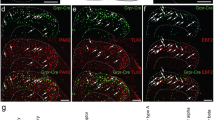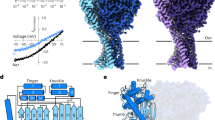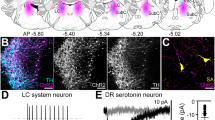Abstract
EVIDENCE is accumulating to support the concept that the pentapeptides Met-enkephalin and Leu-enkephalin, the endogenous ligands for the opiate receptor, function as neuromodulators or neurotransmitters1,2. In the central nervous system the effects of enkephalins are complex and difficult to analyse, and their mode of action at the neuronal membrane level is still poorly understood. The most prominent action of enkephalins in the mammalian brain is depression of neuronal firing rate and it has been suggested that these peptides are inhibitory transmitters1,2. An increase in firing rate by enkephalins has, however, also been reported3. The response of central neurones to several putative transmitter substances is depressed or enhanced by enkephalins, suggesting a postsynaptic action4,5. It has also been shown that enkephalins suppress the K+-induced release of noradrenaline6, dopamine7 and acetylcholine7 from rat brain slices, indicating a presynaptic effect. The firing of myenteric neurones in the guinea-pig ileum is inhibited by enkephalins. This inhibition is probably due to a direct postsynaptic action of the enkephalins resulting in a hyperpolarisation of the neuronal membrane8. Most of the effects of enkephalins are antagonised by the specific opiate antagonist naloxone. Morphine produces effects very similar to those of enkephalins. Because of the possible role of enkephalins in inhibitory synaptic transmission, we studied the effects of Met-enkephalin on slow synaptic inhibition in frog sympathetic ganglion. We report here that Met-enkephalin causes a depression of the slow inhibitory postsynaptic potential (i.p.s.p.), probably mainly by a presynaptic action, and induces a hyper-polarisation of the ganglionic neurones. Both effects are antagonised by naloxone.
This is a preview of subscription content, access via your institution
Access options
Subscribe to this journal
Receive 51 print issues and online access
$199.00 per year
only $3.90 per issue
Buy this article
- Purchase on Springer Link
- Instant access to full article PDF
Prices may be subject to local taxes which are calculated during checkout
Similar content being viewed by others
References
Fredericson, R. C. A. Life Sci. 21, 23–42 (1977).
Terenius, L. A. Rev. Pharmac. 18, 189–204 (1978).
Davies, J. & Dray, A. Nature 262, 603–604 (1976).
Gent, J. P. & Wolstencroft, J. H. in Opiates and Endogenous Opioid Peptides (ed Kosterlitz, H. W.) 217–224 (North-Holland, Amsterdam, 1976).
Segal, M. Neuropharmacology 16, 587–592 (1977).
Taube, H. D., Starke, K. & Borowski, E. Naunyn-Schmiedebergs Archs Pharmak. 299, 123–141 (1977).
Subramanian, N. et al. Naunyn-Schmiedebergs Archs Pharmak. 299, 163–165 (1977).
North, R. A. & Williams, J. T. Nature 264, 460–461 (1976).
Nishi, S. & Koketsu, K. J. Neurophysiol. 31, 717–728 (1968).
North, R. A. & Tonini, M. Neuropharmacology 15, 719–721 (1976).
Smith, P. A. & Weight, F. F. Nature 267, 68–70 (1977).
Plonsey, R. & Fleming, D. A. Bioelectric Phenomena (McGraw-Hill, New York, 1969).
Nishi, S. in Advances in General Cellular Pharmacology (eds Narahashi, T. & Bianchi, C. P.) 179–245 (Plenum, New York, 1976).
Polland, H., Llorens-Cortes, C. & Schwartz, J. C. Nature 268, 745–747 (1977).
Author information
Authors and Affiliations
Rights and permissions
About this article
Cite this article
WOUTERS, W., VAN DEN BERCKEN, J. Hyperpolarisation and depression of slow synaptic inhibition by enkephalin in frog sympathetic ganglion. Nature 277, 53–54 (1979). https://doi.org/10.1038/277053a0
Received:
Accepted:
Issue Date:
DOI: https://doi.org/10.1038/277053a0
This article is cited by
Comments
By submitting a comment you agree to abide by our Terms and Community Guidelines. If you find something abusive or that does not comply with our terms or guidelines please flag it as inappropriate.



